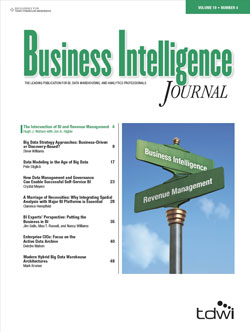
Business Intelligence Journal | Vol. 19, No. 4
TDWI Member Exclusive
December 8, 2014
BI success is rarely attributable to a single cause. Usually it depends on a combination of factors that intersect as we solve our everyday analytics issues.
Senior editor Hugh J. Watson works with Jon A. Higbie to explain why revenue management (selling the right product to the right customer at the right time for the right price) is driving many new big data and BI initiatives. He looks at the huge ROI it can deliver with negligible incremental costs.
Steve Williams compares business-driven and discovery-based approaches to big data strategy. He explains the benefits of taking a discovery-based approach, and looks at the skill sets needed and the investments required.
Pete Stiglich looks at another aspect of big data: data modeling. Given the interest in NoSQL technology (most notably Hadoop) and its flexible schemas, do we really need data modeling any more? Stiglich argues that big data doesn’t reduce the need for data modelers.
Crystal Meyers revisits an age-old problem that still troubles enterprises in an age of big data: data governance and its role in self-service BI. She explains how governance helps us avoid problems from out-of-date or missing data and how power users can strengthen the business-IT relationship.
What good is data if it’s not incorporated into your daily activities? Clarence Hempfield explains why you should put the 80 percent of business data containing actionable location information to work at your enterprise.
The intersection of business and IT is the focus of our BI Experts’ Perspective. Jim Gallo, Max T. Russell, and Nancy Williams offer their advice for helping a BI staff become more business oriented.
Big data meets compliance in Deirdre Mahon’s discussion of the challenges you’ll encounter in archiving analytical data sets. She offers ideas for building a flexible, business-centric, economical archiving infrastructure.
Finally, Mark Kromer discusses how RDBMSs, MPP, and big data platforms can work together so users can enjoy a great experience when exploring data or generating business reports.
As always, we welcome your comments. Please send them to [email protected].
James E. Powell
Editorial Director
Business Intelligence Journal
IN THIS ISSUE
-
The Intersection of BI and Revenue Management
Hugh J. Watson with Jon A. Higbie
-
Big Data Strategy Approaches: Business-Driven or Discovery-Based?
Steve Williams
-
Data Modeling in the Age of Big Data
Pete Stiglich
-
How Data Management and Governance Can Enable Successful Self-Service BI
Crystal Meyers
-
A Marriage of Necessities: Why Integrating Spatial Analysis with Major BI Platforms is Essential
Clarence Hempfield
-
BI Experts’ Perspective: Putting the Business in BI
Jim Gallo, Max T. Russell, and Nancy Williams
-
Enterprise CIOs: Focus on the Active Data Archive
Deirdre Mahon
-
Modern Hybrid Big Data Warehouse Architectures
Mark Kromer